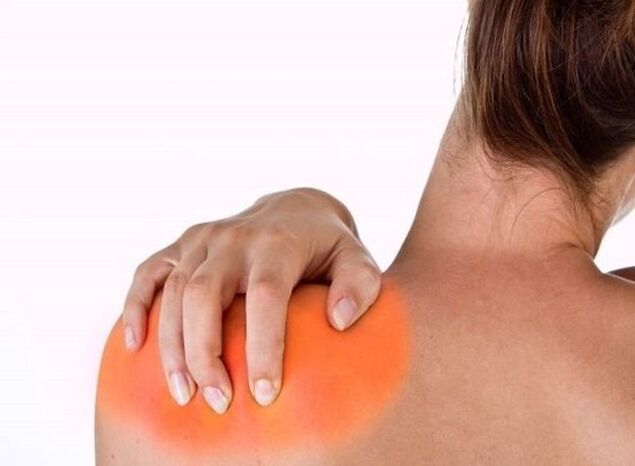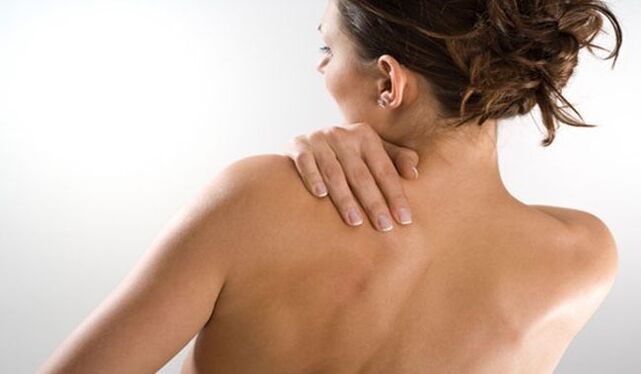Pain on the left under the scapula is a fairly common symptom that can manifest itself in men and women and even children. At first glance, such symptoms may seem insignificant, but in fact the pain under the left left shoulder blade can be a harbinger of a number of dangerous diseases.
There are many reasons for this pain syndrome to occur, and they are generally not related to problems with the shoulder blades themselves. Often the cause of pain is inflammatory and pathological processes in other organs and systems.

Why does the left shoulder hurt under the knife?
To understand why you have pain under the scapula, you need to remember the anatomical structure of a person. In fact, nearby organs often ache, although the pain spreads along nerve fibers far from the center of the disease.
The left shoulder blade is located in the ribs that form the chest. The ribs are connected by ligaments and intercostal muscles, and between each rib are the intercostal veins and the intercostal nerves. In turn, the intercostal nerves are separated from the spinal cord, which is located in the center of the spine, the backbone. The scapula, along with the ribs, protects the left heart, left lung, stomach, spleen, pancreas, and aorta.
Based on this, the causes of pain can be divided into two main groups:
- Pain associated with disorders of the musculoskeletal system, as well as muscle pain.
- Pain associated with pathological changes in the functioning of internal organs (diseases of the gastrointestinal tract, cardiovascular system, spleen, respiratory system).
The cause of scapular pain can be determined by its nature, intensity and localization:
- Pain in the left shoulder blade. . .The pathological source of such pain may be located far from the site of pain. Often this symptom is characteristic of gastric or heart disease.
- Painful pain under the left shoulder blade. . . Indicates the presence of a long-lasting chronic process. Such painful manifestations may be associated with chronic heart disease (pericarditis, myocarditis), as well as cervical osteochondrosis of the spine.
- Dull pain under the left shoulder blade. . . It often occurs against the background of the development of thoracic or cervical osteochondrosis. Pain usually spreads from the back of the head to the back, arms, and under the shoulder blades, and is accompanied by nausea, dizziness, and tingling in the hands.
- Severe pain under the left shoulder blade. . . Severe pain is not characteristic of the scapular zone, ie it serves as a signal of a life-threatening pathological condition. At best, severe pain may indicate intercostal neuralgia, but more often such sensations indicate the presence of a gastric ulcer and the development of a pre-infarction condition.
- Acute pain under the left shoulder blade. . . Intercostal neuralgia can cause severe pain - at the same time, the pain syndrome during inhalation clearly increases, there is a feeling of "shortness of breath". Acute pain can lead to left-sided pneumonia in the acute stage, and the patient feels cutting and stabbing symptoms all over the left side of the chest, spreading to the left shoulder blade. Less often, acute pain can occur with exacerbation of pancreatitis - the pain is shingles and cramps.
- Relieving pain under the left shoulder blade. . .May indicate the initial stage of development of cervical osteochondrosis. The pain begins just below the occipital bone and spreads to the left (or right) side of the back.
- Burning under the scapula. . . This symptom may indicate long-term intercostal neuralgia, angina attacks, myocardial infarction. Occasionally, a burning sensation under the scapula may indicate the development of vegetative-vascular dystonia. In this case, the pain is accompanied by tachycardia, trembling hands, strong fear.
- Constant pain under the left scapula. . . This pain syndrome may indicate the development of left-sided pneumonia. In this case, the pain is accompanied by a dry cough, low temperature, shortness of breath, shortness of breath.
- Suture pain under the left shoulder blade. . .Stitch pain (called "lumbago") is the most common symptom of osteochondrosis, but can also indicate intercostal neuralgia. A tingling sensation in the back as a result of tension, deep inhalation, or coughing may be a sign of pleurisy or pneumonia.
- Pressing pain. . . Indicates the development of osteochondrosis, as well as the initial stage of coronary heart disease and exacerbation of vegetative-vascular dystonia.
- Shocking pain. . .Often the left protrusion of the intervertebral disc in the thoracic or cervical spine manifests itself in this way. Pulsating pain may indicate an intervertebral disc herniation or primary aortic dissection.
- Acute pain under the left shoulder blade. . . Indicates dangerous conditions and requires urgent medical attention. Causes of pain syndrome can be: attacks of angina pectoris, left protrusion of the intervertebral disc, gastric ulcer.

The nature and localization of the pain may vary, but often painful sensations under the left shoulder blade are a very dangerous symptom that requires immediate medical attention.
What diseases can cause pain under the left shoulder blade?
Pain syndrome in the left under the scapula is most often caused by pathologies of the musculoskeletal system, heart, stomach and bronchopulmonary system.
Consider possible diseases and accompanying symptoms associated with pain under the left shoulder blade.
| Diseases | The nature of pain | Related symptoms |
|---|---|---|
| Musculoskeletal system | ||
| Shoulder-scapular periatritis | The pain appears in the shoulder area and spreads to the scapula. | The patient is unable to move freely (pain can not put his hands behind his head), there is a tingling in the joints while moving. |
| Intercostal neuralgia | The painful sensation is localized in one of the intercostal spaces and is accompanied by a feeling of numbness. The pain syndrome is exacerbated when bending to the left. | Redness may appear in the course of the inflamed area, characteristic rashes may appear on the skin. |
| Diseases of the back muscles (myositis, inflammation, lesions) | Low back pain is acute and can be painful in nature. | On the left side, there is pain when the scapula is damaged and the muscles stretch. |
| Oncology | Painful pain or constant sharp pain under the left shoulder blade. | The posterior thoracic portion is deformed by scapular tumors. |
| Trauma | Severe pain syndrome, especially in the first few hours immediately after injury. | If the pain increases with movement, swelling or edema occurs, it may be a fracture of the scapula or rib. |
| Osteochondrosis, spondylosis, thoracic scoliosis, intervertebral hernia | Severe pain manifests itself either continuously or with "lumbago". | There are unpleasant sensations in the spine - the feeling that they are "a stake". |
| Heart disease | ||
| Angina pectoris | Pain in the lower back under the left backbone occurs during tension and spreads to the left arm, left back, and sometimes the left jaw. | Shortness of breath is accompanied by fear of death. |
| Myocardial infarction | Burning pain under the left shoulder blade on the side of the heart. | Heart pain is not relieved by pills. The left arm is numb, there is severe shortness of breath, the sternum begins to "burn". |
| Pericarditis and myocarditis | The painful nature of the pain on the left side. | It is accompanied by a cold, more often seen at night and an increase in temperature. |
| Increased aortic dissection aneurysm | Pain syndrome migrates from top to bottom. Initially, the pain occurs in the chest, then gradually moves under the left shoulder blade and further down the back. | A sharp drop in pressure. |
| Diseases of the bronchopulmonary system | ||
| Left-sided pneumonia | The pain is moderate. | Cough with sputum, wheezing in the lungs, fever. |
| Pleurisy | The pain manifests itself when breathing | Shortness of breath, wheezing in the lungs. |
| Pathologies of the gastrointestinal tract | ||
| Gastric ulcer | Pain under the scapula is accompanied by a burning sensation (more often at night). | Pain associated with eating. |
| Perforated ulcer | Acute and stabbing pain (like stabbing). | Fever, vomiting. |
| Acute pancreatitis | Zone pains can sometimes spread to the side. | Flatulence, recurrent vomiting, fever. |
Other symptoms that accompany pain syndrome can help identify the disease that causes pain in the left scapula:
- The pain intensifies after eating- gastric ulcer, pancreatitis, gastritis.
- When you sneeze, the pain intensifies- bone diseases, trauma, pleurisy, neuralgia, joint and muscle pathologies.
- The pain manifests itself when you turn your head- Osteochondrosis, clavicle damage.
- Pain occurs during swallowing- Esophageal diseases, psychosomatic disorders.
- The pain is accompanied by shortness of breath- pleurisy, cardiac pathology, intercostal neuralgia.
- Cough appears with pain- damage to the respiratory system.
- Appearance of temperature- Infectious and inflammatory processes: pericarditis, purulent pleurisy, subphrenic abscess.
- The pain is accompanied by numbness in the left arm.- angina pectoris, osteochondrosis, myocardial infarction.
- Nausea and belching are accompanied by pain- Pathology of the gastrointestinal tract (pancreatitis, ulcers, gastritis).
- There is a tingling sensation in the tongue with pain- angina pectoris, osteochondrosis, heart attack.

Pain under the scapula in pregnant women has the same causes as in other people, but the risk of developing certain diseases in the future mother is higher. The most likely causes of low back pain in a pregnant woman are osteochondrosis (due to excessive load on the spine), pyelonephritis (displacement of the kidneys and activation of their activity), excessive tension in the back muscles.
Pain under the scapula in children usually occurs as a result of trauma, neuralgia (after hypothermia), myositis, pleurisy.
Diagnosis and treatment. Which doctor should I go to?
Depending on the nature of the pain and its manifestations, you should choose a doctor to make an appointment:
- Emergency doctor- with sharp, severe pain, burning sensation in the chest, shortness of breath, severe dizziness, severe weakness or pain accompanied by fainting.
- Neurologist- if the pain is related to tension or movement.
- Traumatologist- If the pain occurs after an injury.
- Cardiologist- with a burning sensation behind the sternum, under the backbone, in the left arm, lying on the chin.
- Pulmonologist (or therapist)- If the pain increases with breathing and is accompanied by cough, shortness of breath, fever.
- Gastroenterologist- if the pain is associated with food and is accompanied by dyspeptic disorders.
- Surgeon- Pain in the lower back is accompanied by deformity of the sternum, sharp pains accompanied by high fever.
If it is difficult to make an independent decision on the choice of a doctor, it is worth contacting a therapist who will make an appointment with a specialist based on the results of the examination.
Depending on the cause of the pain behind the left shoulder blade, diagnostic measures are prescribed:
- General examination - taking a medical history and talking to the patient, visual examination (pulse, blood pressure, temperature, palpation, listening measurements), blood and urine tests.
- X-ray examination, CT and MRI - detect pathology of the spine and diseases of the musculoskeletal system, as well as diseases of the pulmonary system.
- Ultrasound of the abdominal organs, EGD - gastrointestinal diseases.
- Ultrasound and ECG - prescribed for the examination of cardiovascular diseases.

The treatment regimen for pain under the left shoulder blade is selected specifically for each disease - there is no single treatment protocol.
It is important!Treatment of pain under the left scapula is primarily a treatment of a disease that triggers the pain syndrome.
If the pain is associated with cardiovascular pathology, cardiac medications are prescribed, and a diet that saves physical and psycho-emotional activity is prescribed.
Gastrointestinal pathologies that cause pain are treated with antacids and a mild diet.
Diseases of the musculoskeletal system are treated with long-term therapy, including the use of anti-inflammatory drugs and special therapeutic exercises.
When conservative therapy is ineffective, surgery is prescribed. Surgical intervention is mandatory for perforated ulcers, severe pathologies of the gastrointestinal tract, splenic hernia, intervertebral hernia.
If there is pain under the left shoulder blade, it is necessary to consult a doctor to prevent the occurrence and development of life-threatening pathologies.



































